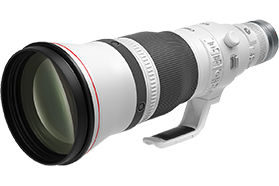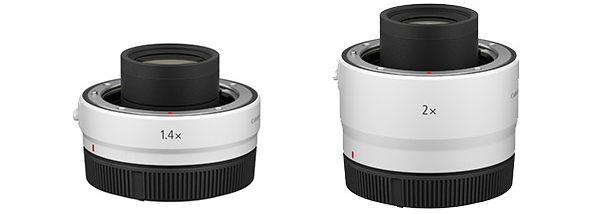Explore null | Canon Latin America

RF 600mm f/4L IS USM
- RF 600mm f/4L IS USM
- Lens Cap E-185C
- Lens Dust Cap RF
- Drop-in Screw Filter Holder 52 (WIII) with 52mm Protect Filter
- Lens Hood ET-160 (WIII)
- Lens Soft Case LS600
- Lens Wide Strap B
-
OVERVIEW
-
SPECIFICATIONS
-
ACCESSORIES
-
RESOURCES
-
SUPPORT
-
MISCELLANEOUS
Capture the action with the RF 600mm f/4L IS USM that offers professional and advanced photographers the excellent image quality of a Canon L series super telephoto lens. Ideal for wildlife, motorsports, and more, the RF 600mm f/4L IS USM provides up to 5.5 stops* of shake correction, delivering consistent and sharp results. Featuring a customizable electronic manual focus ring on the lens barrel, you can select from three different speed levels to adjust manual focus to your desired preference. Additionally, its f/4 aperture and 9-blade circular aperture helps create intimacy in background and foreground bokeh for both photos and videos, and the lens is highly versatile and lightweight as far as 600mm lenses go, making it easier to not only bring it to the action, but capture it even from a distance. The RF 600mm f/4L IS USM makes it easy to bring the action clear and up close.
With the same optical design as the EF 600mm f/4L IS III USM lens, this RF version — dedicated to EOS R-series cameras — brings the same outstanding optical performance to the mirrorless EOS R line. The RF 600mm f/4L IS USM distinguishes itself by maintaining incredibly high image quality expected from a Canon L-series lens, with outstanding overall image quality, even at maximum aperture. The Canon 600mm f/4 L-series lenses have historically combined great telephoto power with tremendous sharpness, contrast and clarity, and the RF 600mm f/4L IS USM continues that tradition.

Optically Identical to EF 600mm f/4L IS III USM lens
Like the EF 600mm f/4L IS III USM lens, introduced in late 2018, the RF 600mm f/4L IS USM is highlighted by significant weight reductions, vs. previous-generation Canon 600mm f/4L designs — opening the doors to using this lens for subjects and situations where telephoto power, wide maximum aperture AND portability are vital. The RF 600mm f/4L IS USM will be outstanding for wildlife, birds in flight, motorsports, and similar applications where portability and the ability to quickly move the camera and lens are vital.

Photo by Zak Noyle, Canon Explorer of Light
Minimum Focusing Distance of 13.78 ft/4.2 m
At its minimum focusing distance of approx. 13.78 ft. /4.2m, the RF 600mm f/4L IS USM can fill the frame with a subject smaller than a regulation, pro-sized US football.

Optical Image Stabilization in the RF600mm F4 L IS USM provides up to 5.5 stops* of shake correction, delivering consistent and sharp results. This helps provide reliable handheld — or monopod-mounted — performance and clear image detail in low-light situations or at lower ISOs. This applies when capturing both stills and video for accurate and clear content.

Three IS Operation Modes
There are three Image Stabilization mode settings, for control of shake-correction — each can be applied with the sliding, 3-position switch on the lens barrel. Mode 1 provides general shake-correction for stills and video, with the continuous stabilization correction visible in the electronic viewfinder whenever it’s active. Mode 2 is designed for stabilization when deliberately panning, providing correction for lens/camera movement that’s perpendicular to the photographer’s intentional panning movement. And Mode 3 provides immediate shake correction, but only when the shutter is actually released — so the effect of stabilization is not visible in the viewfinder, between shots.
The RF 600mm f/4L IS USM lens features Canon's Super Spectra Coating (SSC) that helps maintain overall image quality and color fidelity, as well as Air Sphere Coating (ASC), which significantly helps to reduce the occurrence of lens flare and ghosting regardless of focal length or the angle of light. This helps provide clean results with minimal flare and loss of contrast, especially in heavily back-lit situations.

To help get you even closer to the subject, attach the compatible Extender RF 1.4x or Extender RF 2x to the RF 600mm f/4L IS USM and get the equivalent of 840mm at f/5.6 focal length coverage with the Extender RF 1.4x, or 1200mm at f/8 using the Extender RF 2x. This added flexibility and versatility helps make the RF 600mm f/4L IS USM an amazing option for wildlife photography and more. Canon RF tele extenders transform the lens into an incredibly powerful telephoto combination, with relatively modest additional weight, size and cost.

Featuring a customizable electronic manual focus ring on the lens barrel, the RF 600mm f/4L IS USM allows you to select from three different speed levels to adjust manual focus to your desired preference. Adjusted with a 3-position, Manual Focus Speed switch on the lens barrel, Mode 1 provides the “fastest” setting — minimal rotation of the manual focus ring results in significant shifts in actual focus. The Mode 2 and 3 settings add sensitivity, allowing finer focus control as the ring is rotated. The RF 600mm f/4L IS USM therefore allows the user to select a preference for quick, rapid manual focus changes, or fine manual focus adjustments. Additionally, manual focus is still possible while autofocus is engaged, letting you fine tune focus adjustments to suit your shooting preferences.

Thanks to its 9-blade, circular aperture, the RF 600mm f/4L IS USM is capable of gorgeous, evocative out-of-focus areas and soft backgrounds. Delivering more rounded background blur, the 9-blade circular aperture helps create intimacy and intensity in background and foreground bokeh for both photos and videos.

Photo by Zak Noyle, Canon Explorer of Light
Memorize one — or two — different focus distances, and immediately return to either one with a slight turn of the RF 600mm f/4L IS USM lens’ playback ring, on the lens barrel. A wildlife photographer, for example, can pre-focus on two different spots where he or she expects wildlife to appear, and immediately jump to either memorized position via the playback ring. Full AF or manual focus operation remains available, as well.

Built to L series lens specifications, the RF 600mm f/4L IS USM features a highly durable design for excellent performance even in inclement weather conditions. It delivers a dust- and water-resistant construction with seals around the mount, switches, rings and more. To help maintain a clean lens, even after multiple lens changes in sub-optimal conditions, the RF 600mm f/4L IS USM has a specially designed fluorine coating on its front and rear surfaces. The coating helps to prevent water, oil and other surface residue like fingerprints from sticking to the lens, which facilitates quick and easy wiping, without the use of solvents.

| Focal Length Maximum Aperture | 600mm, F/4-32 |
| Lens Construction | 17 Elements In 13 Groups |
| Diagonal Angle Of View | 04°10′ |
| Closest Focusing Distance | 13.78 Ft. /4.2m |
| Aperture Control | 9 |
| Filter Size | Ø52 Mm (Drop-In Filter — Drop-In Screw-Type Filter Holder 52 [Wiii] Included, With 52mm Clear Protect Filter) |
| Max Diameter X Length Weight | Approx. 6.6 In X 18.6 In. / 168Mm X 472mm, Approx. 6.8 Lbs. / 3090G |

Lens Soft Case LS600
Soft lens case covers and protects your lens from scratches, dust and more when not being used.
)
Lens Hood ET-160 (WIII)
Designed to prevent stray light from entering the lens in order to keep unwanted glare from affecting your photographs.

Lens Dust Cap RF
Helps protect the front glass from dust and scratches.

Lens Cap E-185C
Helps protect the front glass from dust and scratches.
)
Drop-in Gelatin Filter Holder 52 (WIII)
Allows you to fit various gels on your Canon telephoto lenses that accept 52mm filters in their standard holder.
- Windows Server 2025
- macOS 15
- macOS 14
- macOS 13
- Windows 11
- macOS 12
- Windows Server 2022
- macOS 11
- Linux MIPS
- Linux ARM
- macOS 11.0
- macOS 10.15
- macOS v10.13
- macOS v10.14
- Windows Server 2019 (x64)
- macOS v10.14
- macOS v10.13
- Windows Server 2016 (x64)
- macOS v10.12
- Linux 64bit
- Linux 32bit
- OS X v10.11
- Windows 10
- Windows 10 (x64)
- OS X v10.10
- Windows Server 2012 R2 (x64)
- OS X v10.9
- Windows 8.1 (x64)
- Windows 8.1
- Windows Server 2012 (x64)
- Windows 8
- Windows 8 (x64)
- Windows 7
- Windows 7 (x64)
- Windows Vista
- Windows Vista (x64)
- Windows XP
- Windows XP (x64)
- Windows Server 2008
- Windows Server 2008 (x64)
- Windows Server 2008 R2 (x64)
- Windows Server 2003
- Windows Server 2003 (x64)
- Windows Server 2003 R2
- Windows Server 2003 R2 (x64)
- Windows 2000
- Windows NT
- Windows 3.1
- Windows Me
- Windows 98
- Windows 95
- Mac OS X v10.8
- Mac OS X v10.7
- Mac OS X v10.6
- Mac OS X v10.5
- Mac OS X v10.4
- Mac OS X v10.3
- Mac OS X v10.2
- Mac OS X v10.1
- Mac OS X
- Mac OS 9
- Mac OS 8
- Linux (x64)
- Linux (x32)
- Linux
- Not Applicable
Locating and Installing Your Download Cómo Localizar e Instalar su Descarga Localizando e Instalando seu Download
How to identify your OS version
To help determine which Windows operating system is running on your computer, please view the below steps:
Windows 11
Click on the Windows button (located left to the Search at the bottom).
Click on the Settings button to navigate to the system settings.
Scroll to the bottom of the page and click on the About button.
You will be able to find your Windows operating system under the Windows Specifications section.
Windows® 10
Click Start or click the Windows button (usually found in the lower-left corner of your screen).
Click Settings.
Click About (which is usually located within the lower left of the screen). The next screen should display the Windows version.
Windows 8 or Windows 8.1
Option1: Swipe in from the upper-right corner of the screen while viewing the desktop in order to open the menu, then select Settings.
Select PC Info. Under Windows edition, the Windows version is shown.
Option 2: From the Start Screen
While on the Start screen, type computer.
Right-click on the computer icon. If using touch, press and hold on the computer icon.
Click or tap Properties. Under Windows edition, the Windows version is shown.
Windows 7
Click Start or click the Windows button (usually found in the lower-left corner of your screen).
Right-click Computer and select Properties from the menu. The resulting screen should now display the Windows version.
Linux
To check the version of your Linux operating system (OS), you can use the following commands in your terminal:
1. uname -r: Displays your Linux kernel version.
2. cat /etc/os-release: Displays your distribution name and version.
3. lsb_release -a: Displays specific details about your Linux distribution and version.
4. You can also use the hostnamectl command to display the Linux kernel version. However, this command is only available on Linux distributions that use systemd by default.
To help determine which Mac operating system is running on your computer, select the Apple menu in the upper-left corner of your screen and choose About This Mac.
Upon selecting, you should see the macOS name followed by the version number.
Canon U.S.A Inc. All Rights Reserved. Reproduction in whole or part without permission is prohibited.